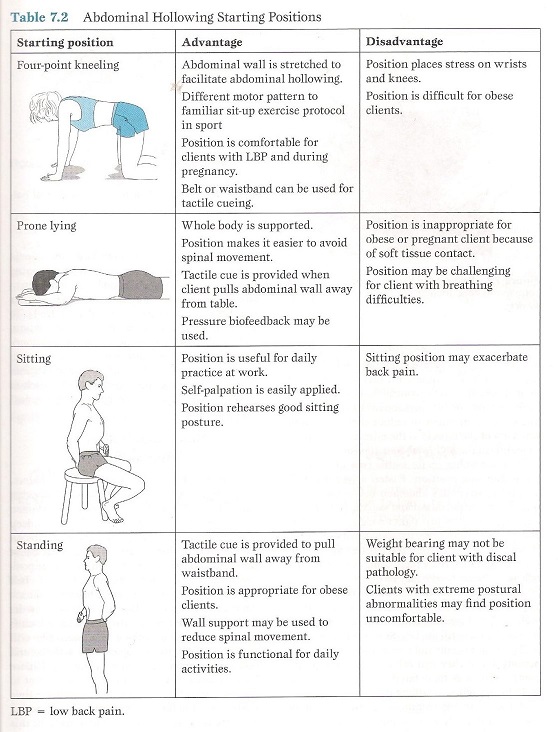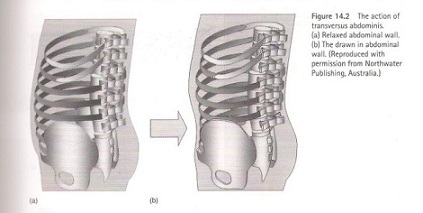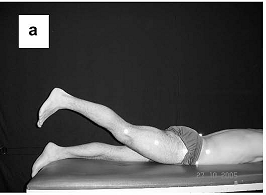Exercises for Lumbar Instability
Original Editors - Bruno Luca
Top Contributors - Laura Ritchie, Bert Lasat, Bruno Luca, Denys Nahornyi, Admin, Jona Van den Broeck, Blessed Denzel Vhudzijena, Kim Jackson, WikiSysop, 127.0.0.1, Evan Thomas, Saeed Dokhnan, Liam Butterworth and Candace Goh - Your name will be added here if you are a lead editor on this page.
Search Strategy[edit | edit source]
Instability AND lumbar spine
transversus abdominis
physiotherapy and lumbar instability
transversus abdominis low back
anatomy back
spinal stabilisation
core stability
exercises back
therapy low back pain
feedforward
Definition/Description[edit | edit source]
Low back pain can be defined as pain or discomfort in the lumbar region. This can be unilaterally of bilaterally. In 85% of the patients low back pain is non-specific. That means that there is pain without a specific medical diagnosis.
People with weak muscle strength and endurance have a great risk at low back pain. It has been shown that weak trunk extensors may lead to chronic low back pain.
Some study’s claim that overweight is also a risk factor, but not every study can prove this.Cite error: Invalid <ref> tag; name cannot be a simple integer. Use a descriptive title
Low back pain is usually due to lumbar (segmental) instability. Lumbar instability is one of the subgroups of non-specific low back pain. Implications of instability are pain, functional disability and reduced muscle endurance.Cite error: Invalid <ref> tag; name cannot be a simple integer. Use a descriptive title
Patients with lumbar instability also show a condition of loss of spinal motion segment stiffness in with normal external loads may cause pain, spinal deformity or damage to the neurological structures. Cite error: Invalid <ref> tag; name cannot be a simple integer. Use a descriptive title
Not all patients show a loss of the feedforward mechanism. But if the feedforward mechanism does not work well, the patients will have more pain. Cite error: Invalid <ref> tag; name cannot be a simple integer. Use a descriptive title
In lumbar motor control training you find more information about the feedforward mechanism.
Therapy exercises for lumbar instability is hard to define. Not only the lumbar region, but also the surrounding anatomical structures must be trained, like the abdominal muscles and some muscles of the lower extremity. The kind of exercises depends on the status of the patient.Cite error: Invalid <ref> tag; name cannot be a simple integer. Use a descriptive titleCite error: Invalid <ref> tag; name cannot be a simple integer. Use a descriptive title
Clinically Relevant Anatomy
[edit | edit source]
Clinically Relevant Anatomy of the low back.
Muscles of the low back: 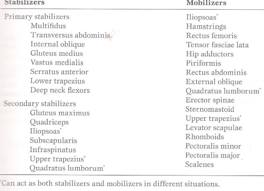
Stabilizing and mobilizing muscles that affect the low backCite error: Invalid <ref> tag; name cannot be a simple integer. Use a descriptive title
Indications for exercises[edit | edit source]
It has been shown that there are different reasons why we should give exercises to patients with lumbar instability. The most important considerations are; which are our goals and is the patient likely to benefit. An important study by Hicks et al, shows that during the examination of lumbar instability positive and negative determinants can be found indicating whether a subject will benefit from a low back stabilization program.Cite error: Invalid <ref> tag; name cannot be a simple integer. Use a descriptive title
There are indications that stabilization exercise programs are used to improve the strength, endurance, and/or motor control of the abdominal and lumbar trunk musculature. Stabilization exercise programs exist of general exercises, educational and workplace-specific back school classes, increase of workload tolerance, psychological interventions and segmental stabilization exercises. The stabilizing exercises focus on the re-education of a precise co-contraction pattern of local muscles of the spine.Cite error: Invalid <ref> tag; name cannot be a simple integer. Use a descriptive title
It had been showed that stabilizing exercises with routine exercises in reduction of pain intensity increasing the functional ability and muscle endurance. It is recommended to use stabilizing exercises in treatment of patients with lumbar segmental instability.Cite error: Invalid <ref> tag; name cannot be a simple integer. Use a descriptive title
This is the guideline about the implications for practicing the local muscle system:
• Develop the skill of an independent contraction of the local muscle synergy;
• Decrease the contribution of the overactive global muscles;
• Use a motor relearning approach to reteach the skill of developing a “corset” action of transverses abdominis and multifidus in response to the cue to draw in the abdominal wall.
• Use specific facilitation and feedback techniques to ensure each segment of the multifidus muscle is activated;
• Use specific feedback techniques to develop kinaesthetic awareness of local muscle contractions;
• Develop ability to hold the “corset” action tonically over extended periods of time
• Use repeated movements of lumbopelvic region, in non-weightbearing positions initially, to improve position sense.Cite error: Invalid <ref> tag; name cannot be a simple integer. Use a descriptive title
Implications for practice of the local muscle system with the global muscle system
• Training the local and weightbearing muscles is likely to reverse impairments in the non-weightbearing muscles;
• Initially use specific facilitation techniques for the dysfunctional weightbearing muscles, with emphasis on increasing weightbearing load cues;
• Use optimal weightbearing postures to re-establish recruitement of both the local and weightbearing muscles;
• Weightbearing muscles should be trained under the stretch from gravity in flexed and more upright postures;
• Use static weightbearing postures with increasing holds and/or very slow and controlled weightbearing exercise to enhance the feedback mechanisms;
• Increase gravitational load cues gradually, ensuring local and weightbearing muscles are responding to the increases in load;
• At a later stage it may be necessary to add in specific muscle-lengthening techniques for non-weightbearing muscles, especially if the muscle tightness is in the passive rather than the active elements of the muscle.Cite error: Invalid <ref> tag; name cannot be a simple integer. Use a descriptive title
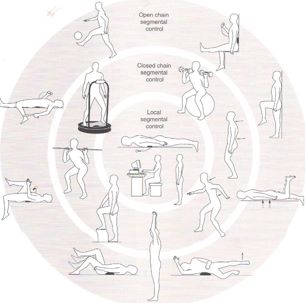
The segmental stabilization model for the prevention and treatment of low back pain Cite error: Invalid <ref> tag; name cannot be a simple integer. Use a descriptive title
The three stages of the exercise model form the building blocks for the development of the joint protection mechanisms, for both low- and high-load functional situations. Each stage includes clinical assessments of the level of impairment in the joint protection mechanisms, followed by the suggested exercise techniques.Cite error: Invalid <ref> tag; name cannot be a simple integer. Use a descriptive title
Exercise techniques[edit | edit source]
The guidline to follow before starting with exercises is to use the stabilizer. A stabilizer has come into general use for stabilization exercises for all parts of the body. A stabilizer is a pressure biofeedback unit and consists of an inelastic, three-section air-filled bag, which is inflated to fill the space between the target body area, a firm surface and a pressure dial for monitoring the pressure in the bag for feedback on position. The bag is inflated to an appropriate level for the purpose and the pressure recorded. Quite simply, movement of the body part off the bag results in a decrease in pressure, while movement of the body part into the bag results in an increase in pressure. Its use in assessing the abdominal drawing-in action has become its most important use in relation to the treatment of problems for the local muscle system in patients with low back pain. Cite error: Invalid <ref> tag; name cannot be a simple integer. Use a descriptive title
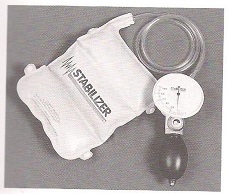 Cite error: Invalid
Cite error: Invalid <ref> tag; name cannot be a simple integer. Use a descriptive title
The patient must be placed in an initial position lying on the back with the hips and knees flexed. The feet remain flat on the floor and the arms must be held alongside the body. The stabilizer is positioned under the low back and there it measures the movements of the spine. During exercises the spine cannot make any movements. The transversus abdominis muscle must be in contraction while doing exercises and this muscle keeps the spine in the right position. On the picture below the woman is holding the feedback machine. Thereon she can see when her spine moves.Cite error: Invalid <ref> tag; name cannot be a simple integer. Use a descriptive title, Cite error: Invalid <ref> tag; name cannot be a simple integer. Use a descriptive title
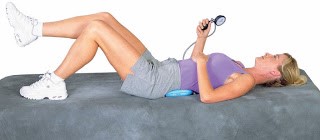 Cite error: Invalid
Cite error: Invalid <ref> tag; name cannot be a simple integer. Use a descriptive title
A. Foundation movements
1) Contracting transversus abdominis muscle.
Goal: Learns to contract the transversus abdominis muscle without contraction of the overlying abdominal muscles.
How to do?
The person pulls his belly in and up at the navel without moving the rib cage, the pelvis or the spine.
Contraction intensity: 30 to 40% of the maximum voluntary contraction ( MVC).
Building:
1) Start with a small contraction.
2)Build up the duration of the contraction.
Only when the patient can control contraction of the transversus abdominis muscle with minimal muscle intensity ( 10 repetitions each 30-40%) over a period of time , the progress should lead to more advanced exercises. Cite error: Invalid <ref> tag; name cannot be a simple integer. Use a descriptive title
A movie of this exercise is shown in spinal stabilization.
The action of the transverses abdominis : (a) relaxed abdominal wall, (b)The drawn in abdominal wall.Cite error: Invalid <ref> tag; name cannot be a simple integer. Use a descriptive title
Normally the transversus abdominis muscle is in contraction always while standing and sitting. Contraction of this muscle creates a good posture. In normal conditions the transversus abdominis muscle contract by itself, but in patients with low back pain the muscle doesn’t happen naturally. This can lead to an unstable core, which is a risk factor for low back pain.
The goal is that patients with low back pain learn to contract the transversus abdominis muscle in al times (except in lying position).
After a time the muscle shut contract naturally. It is very important in patients with low back pain that they have a good posture, that’s why they have to learn to contract the transversus abdominis muscle.Cite error: Invalid <ref> tag; name cannot be a simple integer. Use a descriptive title
2) Contract of the M. multifdus
The mucle is the most important stabilizer of the spinal extensor group. People with low back pain often lose the ability to contract this muscle and they do not regain the ability spontaneously.
How to do?
First the person learn to recognize what is feels like to tense and relax the muscle.
Second focus not only on the multifidus but also on the lateral abdominals. Cite error: Invalid <ref> tag; name cannot be a simple integer. Use a descriptive title
3) Control of the pelvic muscles
This is important to move confidently into a neutral lumbar position. People with low back pain have not the ability to perform pelvic tilting. You can see excessive flexion laxity but limited, or bloked extension.
The ability to dissociate lumbar movement form pelvic movement is therefore important, and correction of faulty lumbar-pelvic rhythm is vital. Cite error: Invalid <ref> tag; name cannot be a simple integer. Use a descriptive title
4) Diafragma
The muscles are also reduced in asociation with rapid limb movement and support surface translation while global muscle activity is increased. It may be predicted that people with respiratory disease may have increased incidence of low back pain. Cite error: Invalid <ref> tag; name cannot be a simple integer. Use a descriptive title
|
Prone kneeling Lumbar-Pelvic Rythm Cite error: Invalid
|
Goal: Facilitate active pelvic tilt. Prone kneeling with shoulders directly above the hands and hip above the knees Phase 1(a): no lumbar or pelvic movement should occur Phase 2(b):posterior pelvic tilt and hip flexion occur Phase 3(c) :Lumbar flexion and some thoracic flexion finish the action (d): Faulty lumbar-pelvic rhythm often shows up when lumbar flexion and posterior pelvic tilt occur immediately. Building: 1) The patient learns the tilting 2) The tilting has to be rhythmic Cite error: Invalid <ref> tag; name cannot be a simple integer. Use a descriptive titleThe control of the pelvic muscles is important to move confidently into a neutral lumbar position. People with low back pain don’t have the ability to perform pelvic tilting. They exhibit also a limited excessive flexion laxity or bloked extension. Cite error: Invalid <ref> tag; name cannot be a simple integer. Use a descriptive titleThe ability to dissociate lumbar movement from pelvic movement is therefore important and the correction of faulty lumbar-pelvic rhythm is vital. Cite error: Invalid <ref> tag; name cannot be a simple integer. Use a descriptive title |
High(two-point) kneeling (assisted) hip hinge action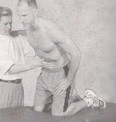 Cite error: Invalid Cite error: Invalid <ref> tag; name cannot be a simple integer. Use a descriptive title
|
Goal: Use a pelvic tilt action to move the spine forward and backward. Once you can perform pelvic tilting well, you should combine it with classic hip in a hinge action where the trunk moves on the hip in a hinge action and the spine remains straight. Avoid any increase or decrease in lumbar lordosis! Draw the abdominal muscles and maintain this minimal contraction throughout the movement! Cite error: Invalid <ref> tag; name cannot be a simple integer. Use a descriptive title |
Sitting pelvic tilt using gym ball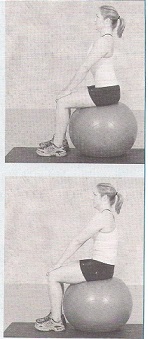 Cite error: Invalid Cite error: Invalid <ref> tag; name cannot be a simple integer. Use a descriptive title
|
Goal: Teach anterior-posterior pelvic tilt control. Sit on the ball with knees apart and feet flat on the floor. Both hips and knees should be flexed to about 90°. Tilt pelvis alternately in both anterior and posterior directions, making sure the shoulders and thoracic spine remain inactive. Start with small ranges of movement. Gradually work up to larger ranges. Cite error: Invalid <ref> tag; name cannot be a simple integer. Use a descriptive title |
Prone lying Multifidus contraction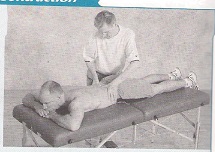 Cite error: Invalid Cite error: Invalid <ref> tag; name cannot be a simple integer. Use a descriptive title
|
Goal: Teach clients to learn to use the multifidus at will and seperately from other muscles. The multifidus is the most important stabilizer of the spinal extensor group. People with low back pain often lose the ability to contract this muscle and do not regain the ability spontaneously. Prone-lying position Therapist palplates the multifidus. Bulge the muscles beneath the fingers of the therapist and differentiate between erector spinae contraction(more lateral) and multifidus contraction(more central). To differentiate between the multifidus muscle and the erector spinae muscle, it’s recommended to contract the erector spinae muslce by hyperextend the trunk. To contract only the multifidus muscle, the patient may not hyperextend the trunk.Cite error: Invalid <ref> tag; name cannot be a simple integer. Use a descriptive titleA movie of this exercise is shown inspinal stabilization. |
Sitting Multifidus contraction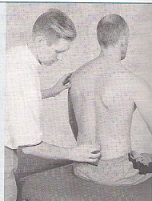 Cite error: Invalid Cite error: Invalid <ref> tag; name cannot be a simple integer. Use a descriptive title
|
Goal: Encourage your client to contract the multifidus and lateral abdominals simultaneously. Client sit on the edge of a bench with his feet on the floor. Lumbar spine in neutral position. Therapist palpates the multifidus. Client performs abdominal hollowing If the therapist feels the contraction, the client can self-palpate and continue the action for 10 repetitions, aiming to hold each for 10 s while breathing normally. Cite error: Invalid <ref> tag; name cannot be a simple integer. Use a descriptive title |
Forward stride(walk) standing multifidus contraction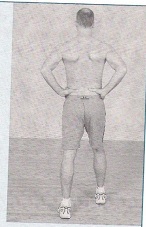 Cite error: Invalid Cite error: Invalid <ref> tag; name cannot be a simple integer. Use a descriptive title
|
Goal: Encourage your client to contract the multifidus and lateral abdominals simultaneously. Stand with one foot in front of the other Self-palpate the L4-L5 level by placing the thumbs on the lower lumbal spinosus process and moving them outward slightly into the spinal tissue. Place the weight onto the front leg and then onto the back leg alternately. Feel the muscles beneath the thumbs switching on and off. Cite error: Invalid <ref> tag; name cannot be a simple integer. Use a descriptive title |
B.Progressing stability training
Heel Slide – Basic Movement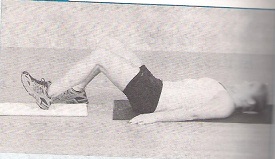 Cite error: Invalid Cite error: Invalid <ref> tag; name cannot be a simple integer. Use a descriptive title
|
Goal: Place minimal but progressive limb loading on the trunk. Slowly straighten one leg with the heel resting on the ground. The moment the pelvis anteriorly tilts and the lordosis increases, you must stop the movement and draw the leg back into flexion. Cite error: Invalid <ref> tag; name cannot be a simple integer. Use a descriptive title |
Leg Lowering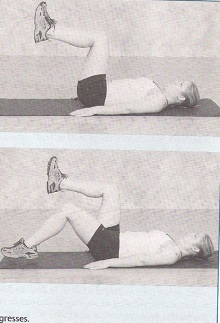 Cite error: Invalid Cite error: Invalid <ref> tag; name cannot be a simple integer. Use a descriptive title
|
This exercise is described in core stability. ‘Leg extensions’ |
Prone-Lying Gluteal Brace Cite error: Invalid Cite error: Invalid <ref> tag; name cannot be a simple integer. Use a descriptive title
|
Goal: co-contract trunk stabilizers with gluteals. Patient has to lie down and dorsiflex the toes. Flex than the knees ( 10°) and the hip (10°). After that contract the gluteal muscles. Cite error: Invalid <ref> tag; name cannot be a simple integer. Use a descriptive title |
Bridge from Crook Lying (Shoulder Bridge) Cite error: Invalid Cite error: Invalid <ref> tag; name cannot be a simple integer. Use a descriptive title
|
This exercise is described in core stability. ‘Dynamic leg and back’ |
Bridge with leg lift Cite error: Invalid Cite error: Invalid <ref> tag; name cannot be a simple integer. Use a descriptive title
|
Goal: progress from bridge from crook lying. The patient starts in crook lying ,then he lifts one leg. Avoid : allow the pelvis to fall toward the unsupported side! Cite error: Invalid <ref> tag; name cannot be a simple integer. Use a descriptive title |
Four-point Kneeling Leg movement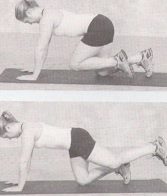 Cite error: Invalid Cite error: Invalid <ref> tag; name cannot be a simple integer. Use a descriptive title
|
This exercise is described in core stability. ‘Hamstrings raising’. |
Four- point Kneeling arm and leg lift (full bridge) Cite error: Invalid Cite error: Invalid <ref> tag; name cannot be a simple integer. Use a descriptive title
|
A movie of this exercise is shown in lumbar spine fracture. ‘Bird dog’ |
Side-Lying spine lengthening Cite error: Invalid Cite error: Invalid <ref> tag; name cannot be a simple integer. Use a descriptive title
|
Goal: control the quadratus lumborum and lateral fibers of the oblique abdominals. Start position: strong co-contraction of the abdominal muscles. Lie on one side, thighs in line with your body and flex the knees 90°. Upper body supported on the same side elbow. Straighten your spine against the force of gravity, leaving the body supported on the forearm of the underneath arm and hip. Cite error: Invalid <ref> tag; name cannot be a simple integer. Use a descriptive title |
Side-lying hip lift Cite error: Invalid Cite error: Invalid <ref> tag; name cannot be a simple integer. Use a descriptive title
|
A movie of this exercise is shown in low back pain and pelvic floor disorders. ‘Oblique abdominals’ |
Side-lying body lift(Side bridge) Cite error: Invalid Cite error: Invalid <ref> tag; name cannot be a simple integer. Use a descriptive title
|
Goal: progress from side-lying spine lengthening. Start position: side-lying spine lengthening. Lift the hips, leaving the body supported on the forearm of the underneath arm and the knees only. Cite error: Invalid <ref> tag; name cannot be a simple integer. Use a descriptive title |
Pelvic shift with leg lift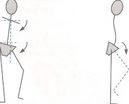 Cite error: Invalid Cite error: Invalid <ref> tag; name cannot be a simple integer. Use a descriptive title
|
Goal: teach pelvic control and stability in single-leg standing. Shift the pelvis to the left, lift slowly the right leg. The supporting leg supports the pelvis and the pelvis supports the back. Raise the knee no more than 45°.Cite error: Invalid <ref> tag; name cannot be a simple integer. Use a descriptive title |
Sitting knee raise Cite error: Invalid Cite error: Invalid <ref> tag; name cannot be a simple integer. Use a descriptive title
|
Goal: maintain pelvic positon against the pull of the hip flexors. Raise one knee, about 8 cm. Unload the limb by lifting the heel. If he is able to maintain good alignment, have him lift the entire leg. Avoid: posterior pelvic tilt! Cite error: Invalid <ref> tag; name cannot be a simple integer. Use a descriptive title |
C.Unstable base
Rapid Displacement in sitting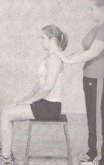 Cite error: Invalid Cite error: Invalid <ref> tag; name cannot be a simple integer. Use a descriptive title
|
Goal: Develop muscle reaction speed for back stability. The patient sit on a chair with her spine optimally aligned. A partner stands behind the person and press on the shoulders in multiple directions; flex, extend and laterally flex the spine. The patient needs to be able to rapidly stabilize his spine. That patient needs to relax the trunck muscles between repetitions. Cite error: Invalid <ref> tag; name cannot be a simple integer. Use a descriptive title[1] |
Throwing and catching on a mobile surface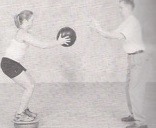 Cite error: Invalid Cite error: Invalid <ref> tag; name cannot be a simple integer. Use a descriptive title
|
Goal: develop rapid-onset back stability. Throwing and catching a bal on a mobil surface while you try to stabilize it.The aim is to align the lumbar spine optimally. Cite error: Invalid <ref> tag; name cannot be a simple integer. Use a descriptive title |
Sitting pelvic tilt, progressing to balance board Cite error: Invalid Cite error: Invalid <ref> tag; name cannot be a simple integer. Use a descriptive title
|
Goal: advanced control of pelvic tilt. The patient needs to sit down on a wooden bench with the feets on the floor. Than hold the pelvis alternately in the anterior and then posterior direction. The aim is to isolate the pelvis and lower lumbar spine from the thoracic spine and the shoulders from the upper lumbar spine. Maintain the position of the shoulders and thoracic spine. Cite error: Invalid <ref> tag; name cannot be a simple integer. Use a descriptive title |
Neutral position maintenance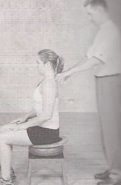 Cite error: Invalid Cite error: Invalid <ref> tag; name cannot be a simple integer. Use a descriptive title
|
Goal: build stability reaction speed in sitting. The patient has to try to balance his body while a person knock the patient. The patient sits in a neutral position on a wobble board. Work gradually up the pressure. Cite error: Invalid <ref> tag; name cannot be a simple integer. Use a descriptive title |
D.Gym ball
Sitting knee raise on gym ball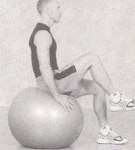 Cite error: Invalid Cite error: Invalid <ref> tag; name cannot be a simple integer. Use a descriptive title
|
This exercise is described in low back pain and pregancy. |
Lying trunk curl with leg lift Cite error: Invalid Cite error: Invalid <ref> tag; name cannot be a simple integer. Use a descriptive title
|
Goal: strengthen upper and lower abdominals. Start position: lying trunk curl over ball. The patient should lift one leg while maintaining the stable position. ! lying over the ball is a good way to stretch the whole spine! Cite error: Invalid <ref> tag; name cannot be a simple integer. Use a descriptive title |
Bridge with therapist pressure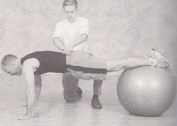 Cite error: Invalid Cite error: Invalid <ref> tag; name cannot be a simple integer. Use a descriptive title
|
Goal: Strengthen hip and trunk stability muscles by challenging stability with continuously variable overload from multiple directions. Start position: the standard bridge, his feets on a ball. The therapist pushes the patient against his pelvis from above and below and side to side. Rapid pushes will decrease muscle reaction time, training the muscles to contract more quickly without loss of intensity. Cite error: Invalid <ref> tag; name cannot be a simple integer. Use a descriptive title |
Basic superman Cite error: Invalid Cite error: Invalid <ref> tag; name cannot be a simple integer. Use a descriptive title
|
Goal: strengthen the spinal and hip extensors. The patient has to lie down with her abdomen on the ball and her feets astride and flat against a wall. Tight the abdominal muscles to form a firm surface pressing against the ball and retract the head. The patient retracts and depresses her shoulders to draw the arms downward and back and extend the thoracic spine to bring the chest off the bal. Cite error: Invalid <ref> tag; name cannot be a simple integer. Use a descriptive title |
Reverse bridge Cite error: Invalid Cite error: Invalid <ref> tag; name cannot be a simple integer. Use a descriptive title
|
Goal: Strengthen back and hip muscles while increasing leg motion control. Start position: high position of the reverse bridge movement. The patient has to roll the ball toward herself by flexing her knees and hips and roll it away by extending her legs again. Cite error: Invalid <ref> tag; name cannot be a simple integer. Use a descriptive title
|
Wall sit Cite error: Invalid Cite error: Invalid <ref> tag; name cannot be a simple integer. Use a descriptive title
|
Goal: Prepare the body for lifting while strengthening the legs to provide power for the lift. Start position: ball between back and wall. 1) Sitting position while rolling the ball down the wall. When he achieves 90° hip and knee flexion, the patient needs to hold the position. 2) Single-leg wall sit, straightening on leg at the knee. Cite error: Invalid <ref> tag; name cannot be a simple integer. Use a descriptive title |
E.Building back fitness and resistence training for Core Strength
Bent knee sit-up Cite error: Invalid Cite error: Invalid <ref> tag; name cannot be a simple integer. Use a descriptive title
|
This exercise is described in core stability. ‘Crunches’ |
Gluteal Stretch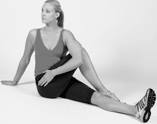 Cite error: Invalid Cite error: Invalid <ref> tag; name cannot be a simple integer. Use a descriptive title
|
The patient sits on the floor with his legs extended. The patient then crosses one leg over the still extended other leg The patient can push with his/her elbow against the lateral side of the knee twist his/her trunk away to get more stretch. |
| Other possible exercises that we only mention -wall bar hanging leg raise Goal: strengthen the lower rectus and providing traction for the lumbar spine -Basic crunch Goal: Work the abdominal muscles in general, with increased emphasis on innerrange activity of the upper abdominals. -Side crunch Goal: Strengthen the oblique abdominals while also working the rectus abdominis -Machine exercises (fitness) Cite error: Invalid <ref> tag; name cannot be a simple integer. Use a descriptive title |
Lower extremity muscle exercises
It is possible that lumbar instability is not only limited to the lumbar spine and the anatomical structures complementing it. Sacro-iliac joint instability for instance plays also a part and can be the cause of low back pain. Studies have found that a big contributor to this sacro-iliac joint instability and low back pain is the malrecruitment of the m. gluteus maximus and m. biceps femoris.Cite error: Invalid <ref> tag; name cannot be a simple integer. Use a descriptive title,Cite error: Invalid <ref> tag; name cannot be a simple integer. Use a descriptive title
The patient has to perform a few slow hip extensions. The physiotherapist places one hand on the M. gluteus maximus of the patient and one on the hamstring muscles. The therapist gives feedback with his hand. The patient has to activate his gluteus maximus first and if he does this correctly he pushes the hand on his gluteus maximus muscles away first, before he does the same with his hamstring muscles.
It has been showed that there is a relationship, especially in muscle coordination, between the muscles that stabilize the lumbar spine and the muscles in the lower extremity, so these muscles has to be trained too, to further achieve coordinated activity between all muscles within a balanced muscular system.Cite error: Invalid <ref> tag; name cannot be a simple integer. Use a descriptive titleThe quadriceps muscles play a part in this relationship also. A study has found that patients with low back pain have deteriorating function of the quadriceps muscles. Endurance and feedforward in the patients quadriceps muscles tend to be weak. The study found that this is due to reduced quadriceps activation after localized lumbar paraspinal fatiguing isometric exercise . Exercises aimed at localized fatigue of the lumbar spine extensors have shown an immediate response in the lower extremity including reduced quadriceps central activation ratio deteriorated balance and response to a balance perturbation. Furthermore they describe a quadriceps fatigability during maximal effort isokinetic knee extension contractions.Cite error: Invalid <ref> tag; name cannot be a simple integer. Use a descriptive title The two main functions of the quadriceps are extension of the knee and flexion of the hip.
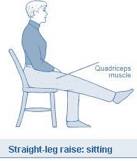 Cite error: Invalid
Cite error: Invalid <ref> tag; name cannot be a simple integer. Use a descriptive title
The patient starts with both his feet on the ground. The patient then straightens one leg and holds this position for about 10 seconds. Then the patient switches legs. To make this exercise a loaded exercise, the patient can do this exercise with weights( for instance on a leg extension machine). Ask the patient to hold for 1-3 seconds.
Exercises for patients who are braced
It has been showed that patients who are braced for lumbar instability benefit from some of the exercises, that are described above. Braced, in this case, means that the patients who were braced were wearing orthesis A study found that patients who are braced and did the following exercises had a decreased level of pain.
- Gluteal and ischiocrural stretching exercises performed in an unloaded way.
- Contraction exercises of the lumbar stabilizing muscles, in particular the m. transverse abdominus.
- Exercises for trunk stabilization on ever more reduced supporting surfaces and finally on unstable surfaces.Cite error: Invalid <ref> tag; name cannot be a simple integer. Use a descriptive title
Key Research[edit | edit source]
Fritz et al. examined the predictive validity of lumbar segmental mobility in patients with LBP. It is possible that patients with segmental hypermobility were more likely to achieve clinical success with stabilization exercises compared with patients without hypermobility.Cite error: Invalid <ref> tag; name cannot be a simple integer. Use a descriptive title
It has been showed in the research of Hides et al. that the Lumbar Multifidus muscle remained atrophied after a 10-week period when patients with acute LBP did not exercise. But this muscle was recovered to normal size in patients who received a stabilization exercise program that stressed deep abdominal and isolated the Lumbar Multifidus muscle contractions.Cite error: Invalid <ref> tag; name cannot be a simple integer. Use a descriptive title
In the study of Richard A et al. some patient groups demonstrated hypertrophy of the Lumbar Multifidus muscles with low-load stabilization exercises. There are indications that the Lumbar Multifidus muscle is inhibited in patients with LBP and the retraining of the muscle to contract may be the major importance during stabilization training. Cite error: Invalid <ref> tag; name cannot be a simple integer. Use a descriptive title
There are also indications that many exercises commonly used by physical therapists in LBP rehabilitation require low to moderate muscle activity of the Lumbar Multifidus and Longissimus thoracicus muscles. To increase the activity of these muscles during exercise, active or resisted lumbar extension is required. Resisted lumbar extension at the end range tends to maximum activity of these muscles.Cite error: Invalid <ref> tag; name cannot be a simple integer. Use a descriptive title
It has been showed that segmental stabilization exercise was more effective than placebo intervention in symptomatic lumbar segmental instability.Cite error: Invalid <ref> tag; name cannot be a simple integer. Use a descriptive title
It also has been showed that specific muscle stabilization retraining is more relevant for patients with either gross spinal symptoms or pronounced side to side differences in the size of the multifidus muscle than for patients that have no signals of instability. Cite error: Invalid <ref> tag; name cannot be a simple integer. Use a descriptive title
The mode of action of stabilization retraining still remains unclear. It has not been shown to be capable of mechanically containing an unstable segment, even upon improvement of muscle activation. No direct long-term effect of stabilization exercises on the status of the local stabilizing muscles has been demonstrated. Cite error: Invalid <ref> tag; name cannot be a simple integer. Use a descriptive title
The commission advises of a study that evaluated the effect of unstable and unilateral resistance exercises on trunk muscle activation revealed that, regardless of stability, the superman exercise was the most effective trunk-stabilizer exercise for back-stabilizer activation. The side bridge was the optimal exercise for lower-abdominal muscle activation. Thus, the most effective means for trunk strengthening should involve back or abdominal exercises with unstable bases. Furthermore, trunk strengthening can also occur when performing resistance exercises for the limbs, if the exercises are performed unilaterally.Cite error: Invalid <ref> tag; name cannot be a simple integer. Use a descriptive title
Resourses[edit | edit source]
There’ re some video’s on physiopedia which show how to perform the exercises described on this page. It’s interesting seeing video’s because it’s easier to understand what you have to do. They are a capital gain to this page.www.physio-pedia.com/Spinal_Stabilization
Clinical Bottom Line[edit | edit source]
On this page there are a lot of exercises. To be sure the patients stays motivated it’s important to take care of variation in the exercises you give. It’s possible using this page to variate your therapy for patients with low back pain.
Recent Related Research (from Pubmet)[edit | edit source]
Prospective study of a new dynamic stabilization system in the treatment of degenerative discopathy and instability of the lumbar spine. http://www.ncbi.nlm.nih.gov/pubmed/22415759 .Cite error: Invalid <ref> tag; name cannot be a simple integer. Use a descriptive title
References[edit | edit source]
see adding references tutorial.
